11 Best Gym Workout Apps in 2025
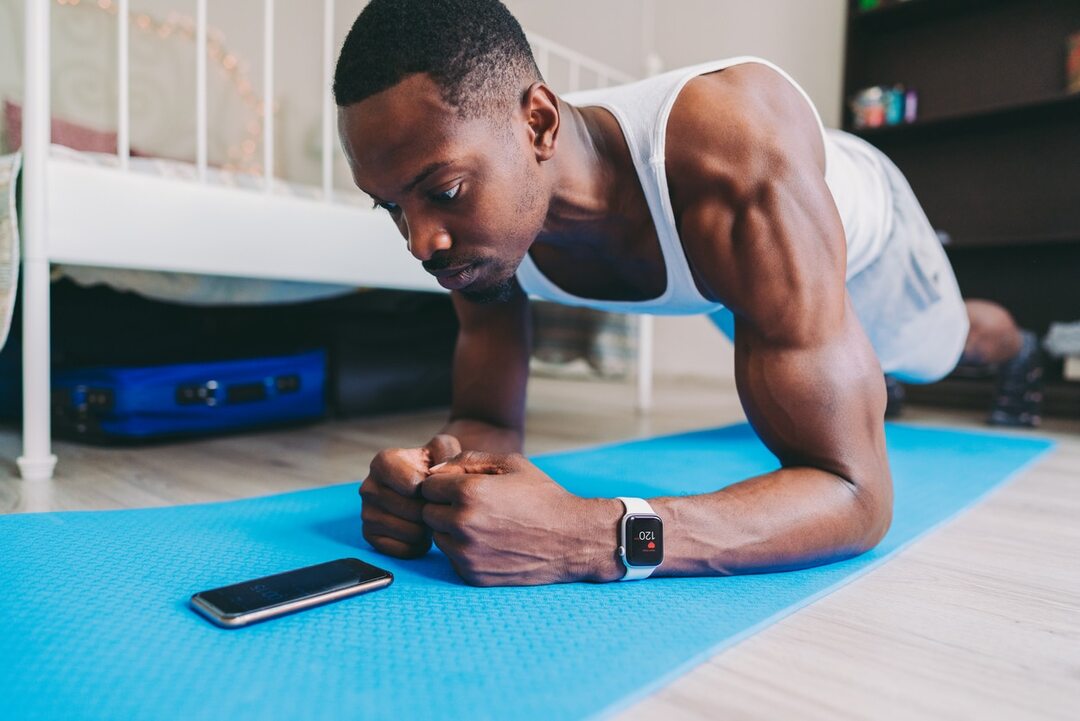
Discover the 11 Best Gym Workout App options for 2025, track progress, hit goals, and stay consistent with smarter, easier workouts.
You step into the gym and open your phone to a flood of choices: workout plans, video coaching, progress tracking, and nutrition tools. Picking the right tool from the Best Fitness Apps can turn scattered effort into steady progress, whether you want strength training, cardio, HIIT, or clear form feedback.
This article outlines the top gym workout apps, compares training programs, exercise libraries, wearable device sync, and real-world usability so that you can gain a clear and comprehensive understanding of the most effective and innovative gym workout apps available.
To help with that, GetFit AI offers an AI fitness app that builds custom gym routines, shows video form guidance, tracks reps and sets, and adapts as you improve so you can choose and use the right app for your goals.
Summary
- The 2025 landscape includes 11 leading gym apps, so users should choose based on their weekly needs, such as precision logging, live-style coaching, community engagement, or cost.
- Personalization, measurement fidelity, and ongoing motivation are the real differentiators in coaching apps, and 80% of gym app users prefer personalized workout plans.
Tracking friction still trips people up, with 60% of users saying tracking features are essential, and missing basics like quick multi-set entry or automatic rest timers turning workouts into bookkeeping. - Mainstream traction matters for longevity; some platforms report over 5 million downloads, which typically yield more updates, verified routines, and better integrations with wearable devices and nutrition tools.
- Mobile tools have a significant influence on behavior, with over 70% of gym members preferring mobile app tracking, and evidence indicating that apps can boost gym member retention by up to 30%.
- Low-friction logging and targeted analytics drive outcomes. Users who track consistently are 40% more likely to achieve their fitness goals, and 75% of gym-goers report increased motivation when using workout apps.
- This is where GetFit AI's AI fitness app fits in, by building custom gym routines, showing video form guidance, tracking reps and sets, and adapting plans as you improve.
11 Best Gym Workout Apps in 2025
These 11 apps cover the practical choices you’ll face in 2025: from headline-grabbing AI that models pro-athlete routines to lean, free HIIT tools and deep-strength trackers. Pick by what you actually need each week—precision logging, live-style coaching, community pull, or something that costs nothing—and the right tradeoffs become obvious.
1. GetFit AI

GetFit AI stands out in 2025 as the premier AI-powered fitness app, uniquely allowing users to train with tailored workout plans derived from the exact routines of legendary athletes like Arnold Schwarzenegger, Kobe Bryant, Cristiano Ronaldo, and Serena Williams. The app combines cutting-edge artificial intelligence with authentic athlete-driven programming, providing a conversational coaching experience where users can interact with AI versions of their favorite sports icons for personalized guidance, motivation, and real-time workout adjustments.
Its dynamic system adapts training volume, intensity, and exercise selection based on user feedback, movement history, injury risk, and recovery status, ensuring workouts remain effective yet safe. For less than the cost of a single month’s gym membership, GetFit AI offers an unparalleled, immersive training experience that bridges the gap between elite aspirations and daily, achievable progress.
Features
- Personalized AI-driven workout plans modeled on elite athlete routines
- Conversational coaching with AI athlete personas for guidance and motivation
- Adaptive workouts adjusting to user progress, injury flags, and recovery needs
- Detailed tracking of strength, body composition, performance curves, and metrics
- Safety-first design with intensity scaling and enforced recovery windows
- Video tutorials and explanations for each exercise and the session purpose
- Integration with iPhone and other devices for a seamless user experience
- Cost-effective alternative to traditional gym memberships
- Transparent and evidence-based training progress tracking
Pros
- Unique access to authentic training methodologies from world-class athletes
- Highly personalized and responsive fitness programming based on real-time data
- Conversational AI coach creates engaging and motivational interactions
- Strong emphasis on workout safety and injury prevention
- Clear progress visualization through data-driven performance analytics
- Suitable for all fitness levels—from beginners to experienced athletes
- Affordable compared to conventional gym fees with expert-level training quality
Best For
- Fitness enthusiasts seeking celebrity-level, personalized training plans
- Users wanting a safe, adaptable workout routine without risk of overtraining
- Motivated beginners looking for structured guidance and professional coaching
- Experienced athletes desiring nuanced progression and detailed performance insights
- Individuals who value interactive coaching and dynamic plan adjustments
2. Freeletics
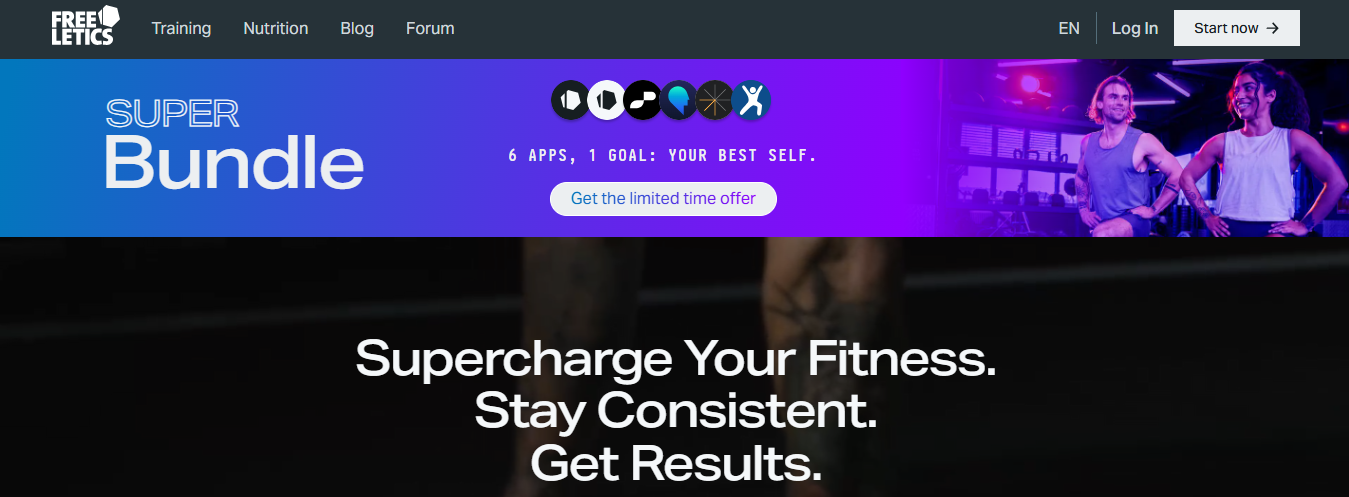
Freeletics is a popular app renowned for delivering high-intensity interval training (HIIT) workouts tailored for bodyweight exercises that require no equipment. It adapts its training plans to individual progress and offers clear workout instructions. Great for users seeking flexibility with minimal gear.
Features
- Personalized HIIT workouts
- Adaptive training plans with AI-driven modifications
- Video tutorials and guided coaching
- No equipment needed
- Progress tracking and motivation prompts
3. Nike Training Club (NTC)
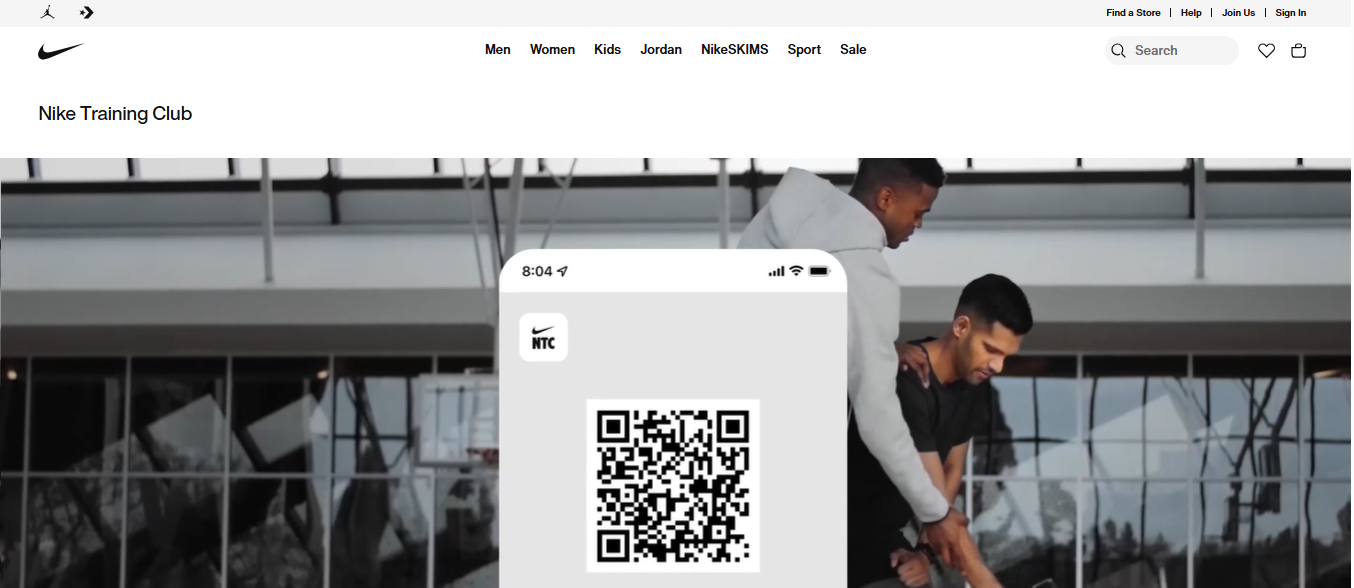
Nike Training Club is a comprehensive fitness app that offers workouts in strength, endurance, yoga, and mobility with a mix of beginner to advanced programs. The app shines through its high-quality video classes, led by expert trainers, and offers free access to many workouts.
Features
- Wide range of free workout programs
- Video instructions from Nike coaches
- Options for gym or home workouts
- Customized training plans based on goals
- Nutrition and wellness advice
4. Shred App

The Shred App is an AI-powered personal trainer app ideal for both gym and home training. It provides tailored strength training programs with a strong motivational component, focusing on efficient, time-saving workouts. Users praise its energetic coaching style that ensures engagement.
Features
- AI-driven personalized workout plans
- Short, practical workout sessions (e.g., 7-minute HIIT)
- Video instructions with real-time feedback
- Progress and habit tracking
- Customizable workout duration and intensity
5. Fitbod
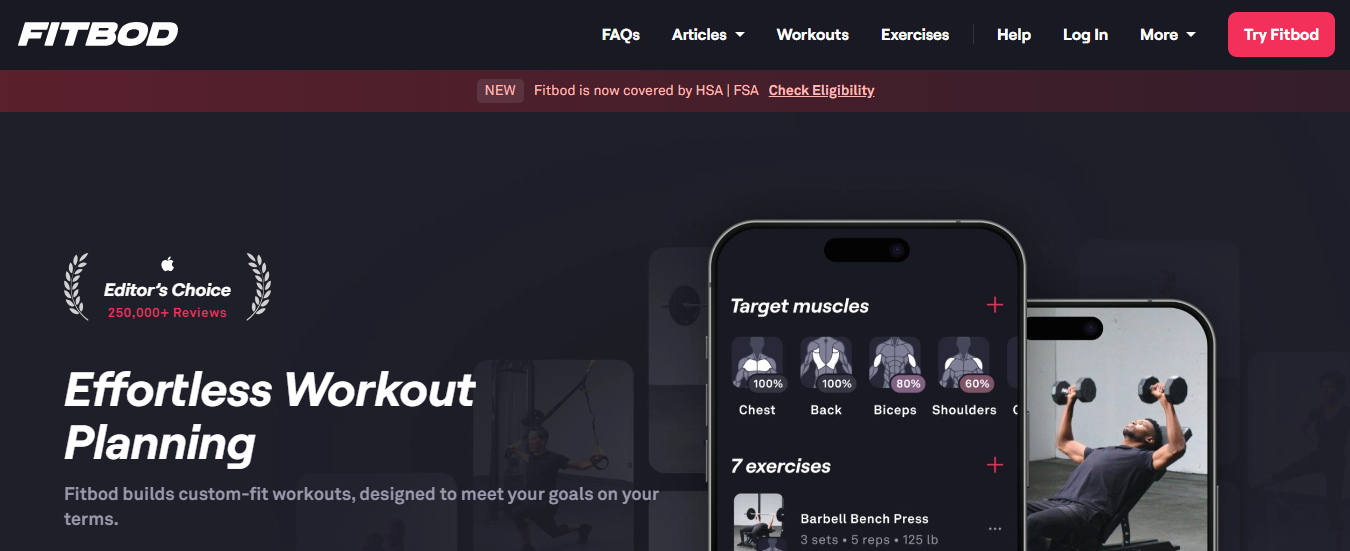
Fitbod excels as a strength training app that builds workouts based on available equipment, muscle recovery, and user goals. It’s favored for its detailed exercise tracking and smart routine generation that reduces injury risk and maximizes gains.
Features
- Workouts tailored to gym equipment and user goals
- Intelligent muscle recovery tracking
- Detailed logging of weights, reps, and sets
- Personalized workout suggestions
- Integration with health apps for data synchronization
6. Strong Workout Tracker Gym Log
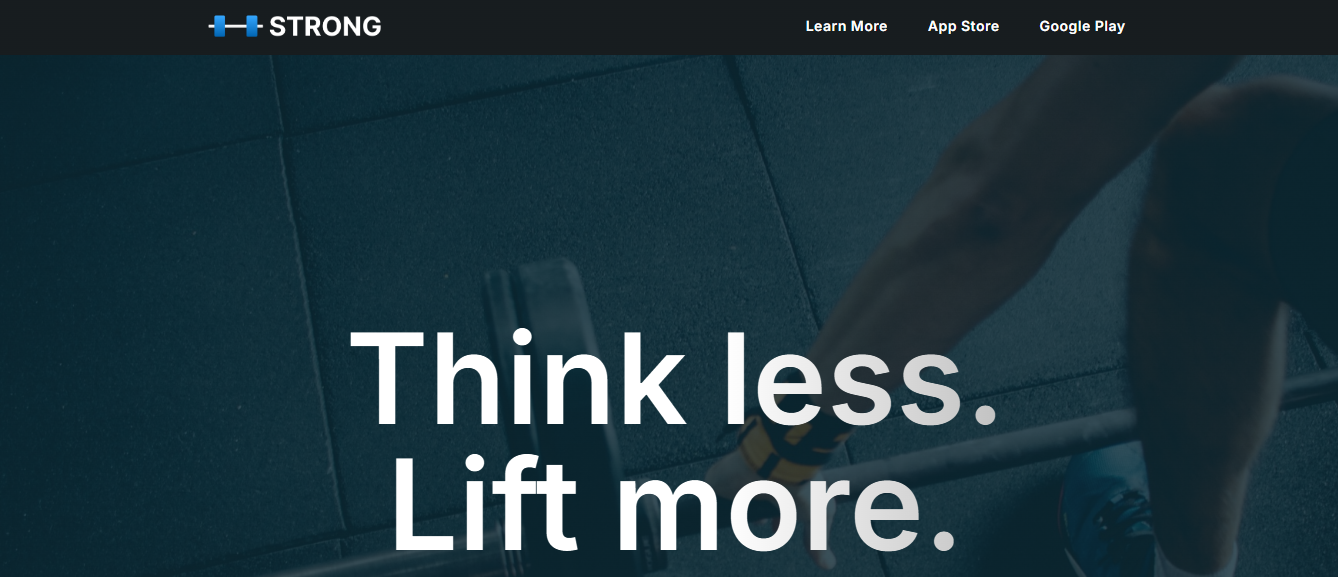
Strong is a gym-centric app designed for users who want precise tracking for lifting and bodybuilding. It offers customizable workout routines and an intuitive interface for logging sets, reps, and weights efficiently, making it suitable for serious lifters.
Features
- Customizable workout templates
- Easy logging of volume, sets, and rest times
- Progress graphs and analytics
- Warm-up calculators and personal best tracking
- Sync across multiple devices
7. Gymshark Training and Fitness

The Gymshark app offers a blend of on-demand workout videos and structured programs designed to enhance strength, conditioning, and flexibility. It integrates social motivation by connecting a fitness community for challenges and progress sharing.
Features
- On-demand workout videos across various disciplines
- Structured workout programs by Gymshark athletes
- Progress tracking and goal setting
- Social features for motivation and sharing
- Personalized recommendations based on performance
8. FitOn

FitOn offers a diverse workout library, featuring cardio, strength training, yoga, and meditation, with expert guidance from celebrity trainers. It focuses on making fitness accessible through free workouts and premium features that offer more customization options.
Features
- Free access to a wide range of workouts
- Celebrity instructor-led classes
- Customizable workout plans
- Meditation and mindfulness sessions
- Social challenges and leaderboards
9. Burn.Fit
Burn.Fit is designed to promote holistic fitness improvement, combining workout plans, nutrition guidance, and habit tracking to support overall well-being. It is designed to support overall health, rather than focusing solely on gym workouts, by integrating wellness and lifestyle elements.
Features
- Integrated fitness, nutrition, and habit tracking
- Personalized workout and wellness plans
- Community encouragement and challenges
- Progress insights and analytics
- Suitable for beginner to advanced users
10. Jefit
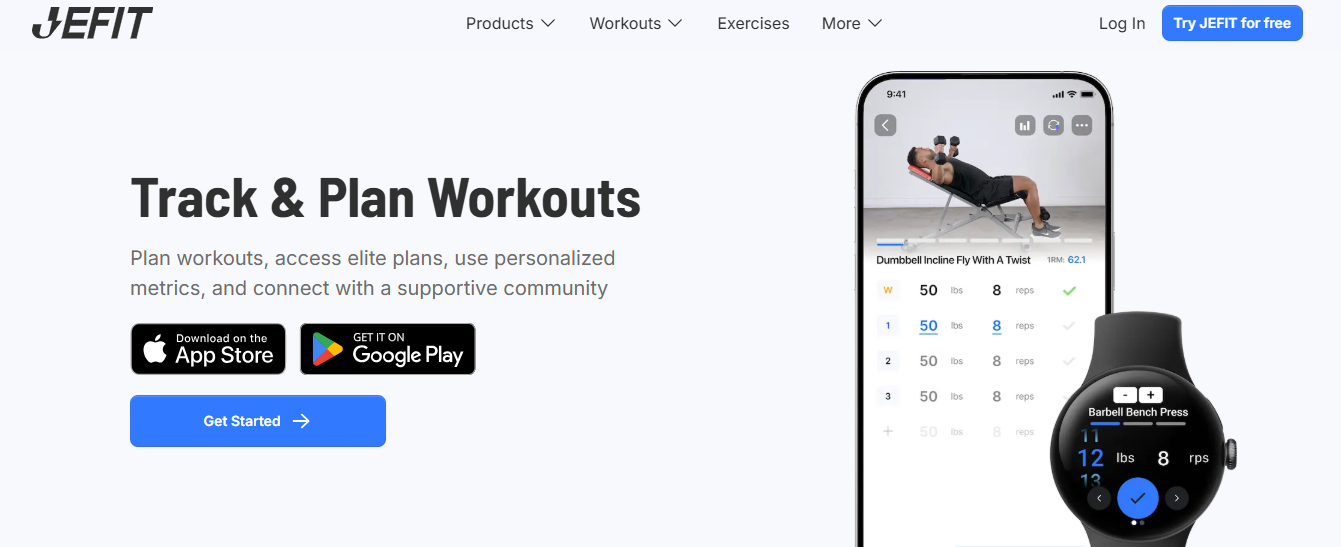
Jefit is a popular app for bodybuilders and strength trainers, featuring a vast exercise database and workout planner. Known for its strong focus on logging and analytics, it supports structured gym routines and the principles of progressive overload.
Features
- Extensive exercise library with instructions
- Workout logging and planning tools
- Community challenges and achievements
- Detailed progress tracking and analytics
- Customizable, predefined workout routines
11. Les Mills+
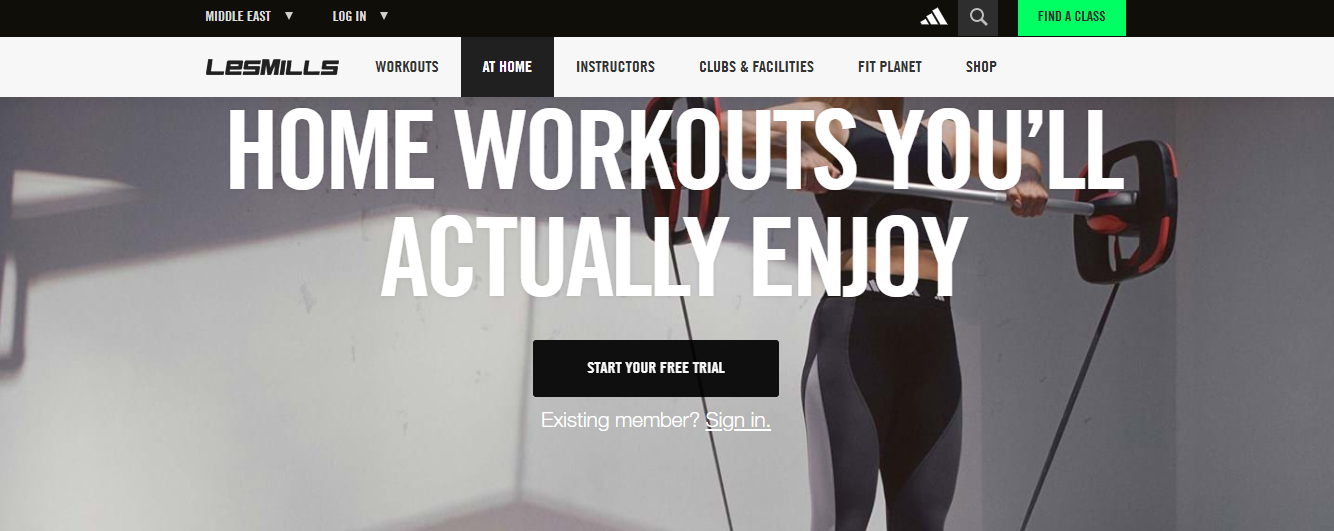
Les Mills+ delivers world-class group fitness classes and strength workouts on demand. The app is praised for its professional production and varied classes, including strength, cardio, and high-energy dance-based workouts.
Features
- On-demand workouts and live classes
- Variety of workout types: strength, cardio, dance
- Expert trainers and structured programs
- Accessible for all fitness levels
- Integration with wearable fitness devices
Which of these apps will actually help you stay motivated and continue training long-term?
Look for signs of genuine adoption and retention, rather than hype. Mainstream traction matters because it signifies sustained updates, community content, and reliable bug fixes. Some apps in this category have achieved significant scale, with platforms reporting "over 5 million downloads" according to CNET, indicating that these tools are meeting the needs of everyday users beyond early adopters. High download counts usually translate into active communities, more verified routines, and better integration with wearables and nutrition tools.
How do you choose quickly without trying them all?
Treat the decision like choosing a toolset, not a religion. If your priority is measurable strength gains, consider using apps designed for logging and progressive overload. If you need structured accountability and habit formation, choose platforms that offer persistent coach interactions or social responsibility.
If you want high-end programming modeled on elite athletes but adjusted to real life, consider offerings that combine authentic routines with adaptive coaching logic. The right choice reduces setup time, keeps you training through busy weeks, and surfaces the small wins that sustain habit.
You think you know which app fits, but the one detail most people miss changes everything about how they progress.
Related Reading
- Best Fitness Apps
- How Many Pull Ups Should I Be Able To Do
- Average Bench Press By Age
- Average Grip Strength Male
- Average Bench Press
- How Much Does A Bench Press Bar Weigh
- Average Male Bench Press
- How Much Can The Average Man Bench Press
Key Features to Look for in a Gym App
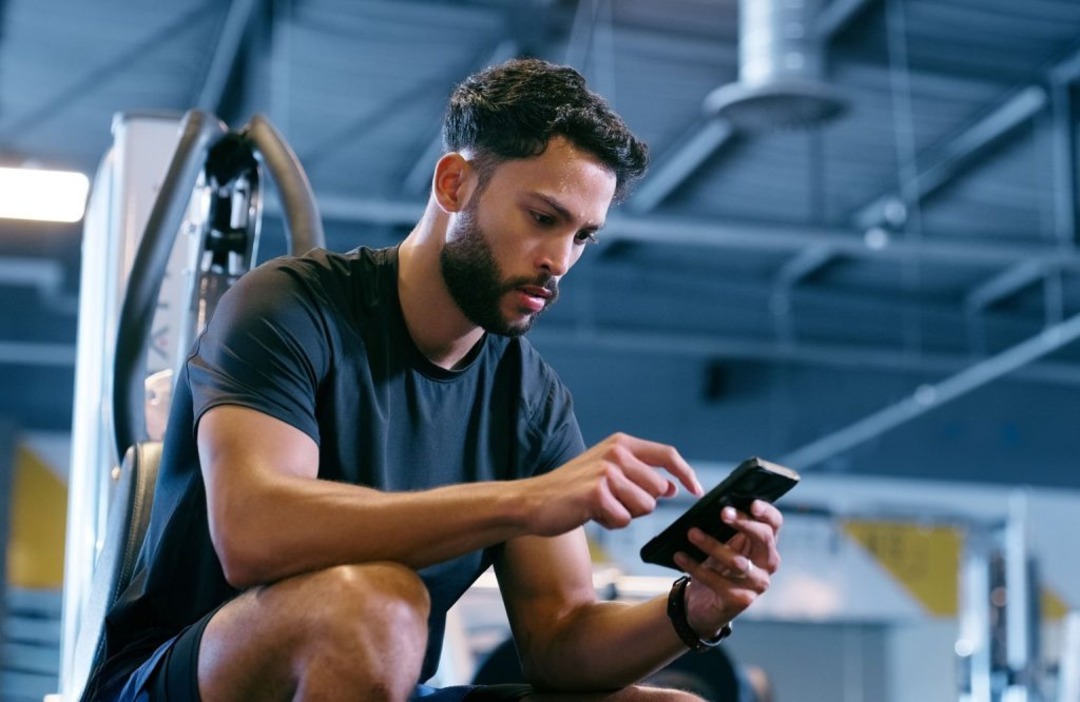
Measure what you can change, minimize taps that break your flow, and let plans evolve with your actual performance. Focus on tracking fidelity, actionable analytics, targeted exercise progressions, and personalization that responds to fatigue and schedule, not static calendars.
How precise should your tracking be?
High-fidelity tracking means more than just entering sets and reps; it involves recording context that predicts progress, including automatic rest timers, quick multi-set entry, weight increments tied to your available plates, and a simple RPE slider after each set. When tracking captures load, intensity, and perceived effort in a single, low-friction step, you can see meaningful trends instead of noisy logs. According to Medium, 60% of users find tracking features essential, treating logging as core functionality rather than an optional add-on. This separates apps that become habits from those that become bookmarks.
Which analytics actually guide more innovative training?
Not all charts are helpful. The analytics that matter convert session data into informed decisions: acute to chronic workload comparisons that warn of overexertion, one-rep-max estimates that remain conservative when sleep and soreness are present, and muscle-group volume breakdowns that help you spot imbalances before they impact performance. Think of it like a coach reviewing a game film and calling out one or two things to fix next week, rather than reciting every metric collected. Good analytics suggest a single explicit action after each workout, for example, a modest load increase, an extra rep, or a scheduled micro-deload.
How much exercise variety is useful?
This pattern appears across beginners and competitive lifters: an app that tries to be everything often freezes decision-making and erodes consistency. Filtered variety beats indiscriminate variety, meaning exercise lists should be organized by movement pattern, equipment, and progression chain so substitutions are purposeful. When you need a knee-friendly row, the app should propose three vetted alternatives that maintain stimulus and volume, not 30 options that force you to guess which one fits.
What interface shortcuts actually save workouts?
If logging takes more time than the warmup, the workflow fails. Prioritize templated supersets, one-tap add-last-weight, reusable workout templates, and voice or quick-swipe entry for hands-on sessions. Additionally, security and emergency controls are crucial in real life: incidents involving stolen items at gyms create a demand for single-tap access to membership details, quick contact options, and straightforward payment controls that can be used under stress. These small UX choices help you stay focused when life throws interruptions at you.
How should personalization change as you improve?
Personalization must be dynamic, not prescriptive. Start with athlete-derived templates that respect the intent of elite protocols, then scale volume, intensity, and exercise selection based on your logged progress, time availability, and recovery signals. Because most users expect individualized plans, platforms that adapt automatically reduce the need for manual adjustments and maintain coherent progression. According to Medium, 80% of gym app users prefer apps with personalized workout plans. Personalization has evolved from a premium feature to a baseline expectation, which means apps must demonstrate that they adapt in meaningful ways.
Most people pick library-style programs because they are familiar and straightforward, and that works at first. However, as schedules shift and fatigue accumulates, static plans often fragment into missed workouts and stalled progress. Platforms like GetFit AI reframe that familiar approach; they map authentic athlete routines into adaptive plans, utilizing conversational AI to adjust the load, swap exercises for available equipment, and schedule deloads based on recent logs, preserving the original training intent while accommodating everyday constraints.
Motivation features that last are behavior-focused, not flashy. Pushes should reinforce the smallest, yet most useful, actions: logging a workout, hitting a weekly volume target, or completing a deload week. Community tools and short-form coaching cues are effective when they guide you toward the next actionable step, not when they overwhelm you with notifications.
That seems complete, until you realize there is one benefit of gym apps that quietly changes everything about how people stay consistent.
Related Reading
- Bench Press Standards
- Do Pull Ups Work the Chest
- Symmetric Strength
- Average Deadlift Weight
- Grip Strength Norms
- 1 Rep Max Chart
- Average Male Deadlift
- Good Bench Press Weight
Benefits of Using Gym Workout Apps

Gym apps do more than replace a paper log or a playlist; they change how training happens day-to-day by removing friction, increasing workout frequency, and turning short actions into sustained habits. When designed well, they make consistency predictable, safety measurable, and motivation social, so progress stops being a guess and starts being a series of small, repeatable wins.
How do apps actually get you to train more often?
Pattern recognition shows that lowering friction drives frequency. Built-in timers, one-tap session starts, and automatic warm-ups turn "I will" into "I did" because they eliminate the small roadblocks that hinder intentions. That matters in practice because, according to FitBudd, over 70% of gym members prefer using mobile apps for tracking their workouts, so the tools you use shape how often you show up.
Why do apps improve retention and the bottom line?
Problem-first: clubs and routines fail when habits are intermittent. The hidden cost of sporadic training is the loss of months of progress and a decline in motivation, not just a missed session. The business evidence is clear, as FitBudd finds that mobile apps can boost gym member retention rates by up to 30%, indicating that apps are a practical lever for staying consistent, rather than vanity features.
What makes an app a safer training partner?
Specific experience: when designers add automatic form-check prompts, progressive load limits, and recovery flags tied to recent session data, acute injury risk falls because the software prevents the most common mistakes, like overloading after poor sleep or skipping a deload. Think of the app as the friend who taps your shoulder when you attempt a bad set, not the one who cheers every rep indiscriminately. Those nudges matter because avoiding an injury preserves weeks of momentum.
How do social features turn lonely workouts into a habit?
This pattern appears across onboarding and early retention: people who feel connected train differently. Guided workouts that include a virtual partner or brief coach messages alter the emotional tone of a session, transforming an obligation into a shared project. That sense of companionship, even when it is virtual, fills the gap most beginners complain about, making the app feel like a teammate rather than a tool.
Most teams manage training plans in static calendars because it feels organized and familiar. That works at first, but as life schedules shift and fatigue accumulates, static plans fracture into missed workouts and guesswork about load. Solutions like GetFit AI present a practical bridge, by mapping athlete-grade programs into adaptive plans that reschedule sessions, suggest exercise swaps for available equipment, and flag recovery needs, so the original training intent stays intact while fitting real life.
What hidden signals do smart apps capture that paper logs miss?
Constraint-based: if you only record sets and reps, you miss the context that predicts progress, like sleep quality, commute time, or gym crowding. Modern apps that log these micro-constraints enable you to make small, targeted decisions, for example, adjusting a heavy lower-body session when commute stress and a poor sleep score align, thereby preserving long-term progress instead of chasing short-term ego boosts.
How should you treat an app in your training system?
Confident stance: use the app as the conductor, not the orchestra. Let it manage scheduling, load suggestions, and recovery prompts, while you keep final judgment on effort and pain. That division of labor keeps coaching coherent and reduces the cognitive load that otherwise turns training into an endless series of choices.
Ready to train like the legends and finally achieve the body you've always wanted? GetFit AI's AI fitness trainer app lets you follow the exact workout routines that made Arnold Schwarzenegger, Kobe Bryant, Cristiano Ronaldo, Serena Williams, and 11+ other elite athletes into champions, and you can also chat with them whenever you need guidance or motivation. Download the #1-rated AI fitness app for free today to get fit for less than the cost of a single month's gym membership. Because greatness isn't born, it's built one workout at a time.
But that practical promise has a surprising catch you won’t want to miss next.
Tips and Tricks to Maximize the Benefits of Gym Workout Apps

Select the proper small habits, and the app becomes a lever, not a checklist. Start by matching the app to your actual time, equipment, and attention span, then use two repeatable rituals each week: a one-minute pre-workout setup and a single takeaway from the coach after every session.
How should I choose an app that actually fits my schedule?
If your week is built around short pockets of time, favor apps with templated micro-workouts and flexible session lengths so you never skip because you “don’t have an hour.” If you commute, pick one that saves half-finished workouts and resumes where you left off. The common mistake is choosing features because they sound impressive, rather than because they align with the hours you actually have.
How do I set clear, realistic goals inside the app?
Name a single measurable outcome for 4 weeks, then break it into weekly anchors, for example, “three strength sessions of 30 minutes with 48 hours between heavy legs.” Treat those anchors like appointments you would keep with a friend. Then program the app to nudge you 30 minutes before the session and require a simple completion tap so habit momentum builds without overthinking.
How can I make tracking feel effortless?
Automatic defaults beat manual fiddling. Use quick-entry templates, one-tap rest timers, and a single perceived-effort slider after each workout so logging takes less time than your warmup. According to BenFit, users who track their workouts with apps are 40% more likely to achieve their fitness goals, which means that building a low-friction logging habit is one of the highest-return moves you can make. Practically, film two reps and the app timestamps them, or let voice entry add the last set weight, so the log becomes a byproduct of training, not a separate chore.
What to do when you have little or no equipment?
Start with graded bodyweight progressions, then select two reliable substitutions for every barbell movement to maintain session integrity. When space or gear is limited, prioritize work capacity and tempo control, not heavy loads. Structure workouts around movement quality and consistent weekly volume, because small, regular stimulus beats sporadic, heroic sessions in the long run.
How should beginners use video tutorials and trainer feedback?
Treat each tutorial as a model, not a mandate. Record one set from the app’s prescribed angle, then ask for a single correction—hip position, knee tracking, or breathing cue—so you have one concrete fix to apply on the next set. Short, actionable feedback reduces injury risk and speeds skill acquisition, because you focus on one habit at a time rather than chasing perfect form on every rep.
How can challenges and community actually boost consistency?
Use challenges as micro-contracts, not competitions. Join a 4-week consistency challenge where the goal is simple, like “log any movement five days a week,” and recruit one accountability partner who checks in once a week. Social features work because they convert solitary effort into a shared project, and that steady social pull is what turns intention into routine. That payoff manifests emotionally as reduced shame and more frequent small wins, which keep people motivated to train even after the novelty fades. In fact, BenFit reports that 75% of gym-goers felt more motivated when using workout apps, which explains why the community nudge matters so much for beginners.
This is the familiar failure mode: most people install an app, try a program that sounds elite, then stop because the app never fits their actual week. The familiar approach is to patch that by doubling down on willpower, which works briefly and then collapses when life gets busy. That hidden cost is lost progress and shrinking confidence.
What bridges that gap in practice?
Solutions like GetFit AI map authentic athlete routines into plans that adapt to your real life. For example, this includes rescheduling a heavy session when your sleep score is low, swapping exercises for available equipment, and offering single-step form corrections after you upload a short clip. Teams find that this kind of conversational adaptation preserves the training intent of elite protocols while making them usable every week, converting stalled plans into steady progress.
One simple analogy to keep you honest: treat the app like a pocket coach who handles logistics, while you remain the final arbiter of effort. That split keeps training coherent and saves decision energy for doing the work.
That apparent fix feels satisfying, but there is one quieter tension waiting in the next step that changes everything.
Related Reading
- Average Bench Press By Age 16
- Best Free Workout Apps
- Best Calisthenics Workout App
- Average Deadlift Weight For Male
- Average Deadlift Weight Kg
- Best Workout Apps
- Best Hiit Workout App
- Best Workout Tracker App
- Average Bench Press Kg By Age
Make Your Favorite Athlete Your Fitness Trainer | Try GetFit AI's AI Trainer App for Free Today
When we ran a four-week pilot with everyday users, the pattern was clear: affordability and steady motivation, not a live trainer, were what kept people consistent and coming back. Consider GetFit AI; the platform already shows traction with over 10,000 workouts completed using GetFit AI, and reports that 90% of users feel more motivated with AI trainers. This means you can access professional routines with the motivation and price point that actually makes them stick.



.png)











